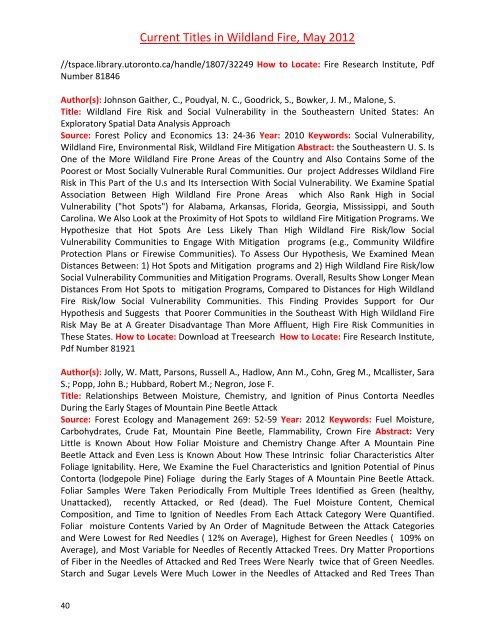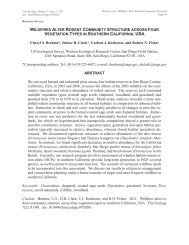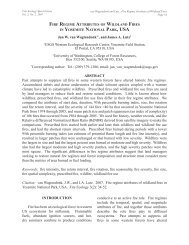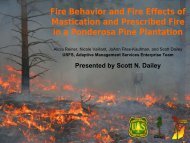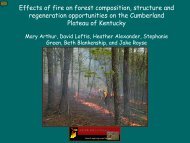Current Titles in Wildland Fire, May 2012 - Association for Fire Ecology
Current Titles in Wildland Fire, May 2012 - Association for Fire Ecology
Current Titles in Wildland Fire, May 2012 - Association for Fire Ecology
Create successful ePaper yourself
Turn your PDF publications into a flip-book with our unique Google optimized e-Paper software.
<strong>Current</strong> <strong>Titles</strong> <strong>in</strong> <strong>Wildland</strong> <strong>Fire</strong>, <strong>May</strong> <strong>2012</strong><br />
//tspace.library.utoronto.ca/handle/1807/32249 How to Locate: <strong>Fire</strong> Research Institute, Pdf<br />
Number 81846<br />
Author(s): Johnson Gaither, C., Poudyal, N. C., Goodrick, S., Bowker, J. M., Malone, S.<br />
Title: <strong>Wildland</strong> <strong>Fire</strong> Risk and Social Vulnerability <strong>in</strong> the Southeastern United States: An<br />
Exploratory Spatial Data Analysis Approach<br />
Source: Forest Policy and Economics 13: 24-36 Year: 2010 Keywords: Social Vulnerability,<br />
<strong>Wildland</strong> <strong>Fire</strong>, Environmental Risk, <strong>Wildland</strong> <strong>Fire</strong> Mitigation Abstract: the Southeastern U. S. Is<br />
One of the More <strong>Wildland</strong> <strong>Fire</strong> Prone Areas of the Country and Also Conta<strong>in</strong>s Some of the<br />
Poorest or Most Socially Vulnerable Rural Communities. Our project Addresses <strong>Wildland</strong> <strong>Fire</strong><br />
Risk <strong>in</strong> This Part of the U.s and Its Intersection With Social Vulnerability. We Exam<strong>in</strong>e Spatial<br />
<strong>Association</strong> Between High <strong>Wildland</strong> <strong>Fire</strong> Prone Areas which Also Rank High <strong>in</strong> Social<br />
Vulnerability ("hot Spots") <strong>for</strong> Alabama, Arkansas, Florida, Georgia, Mississippi, and South<br />
Carol<strong>in</strong>a. We Also Look at the Proximity of Hot Spots to wildland <strong>Fire</strong> Mitigation Programs. We<br />
Hypothesize that Hot Spots Are Less Likely Than High <strong>Wildland</strong> <strong>Fire</strong> Risk/low Social<br />
Vulnerability Communities to Engage With Mitigation programs (e.g., Community Wildfire<br />
Protection Plans or <strong>Fire</strong>wise Communities). To Assess Our Hypothesis, We Exam<strong>in</strong>ed Mean<br />
Distances Between: 1) Hot Spots and Mitigation programs and 2) High <strong>Wildland</strong> <strong>Fire</strong> Risk/low<br />
Social Vulnerability Communities and Mitigation Programs. Overall, Results Show Longer Mean<br />
Distances From Hot Spots to mitigation Programs, Compared to Distances <strong>for</strong> High <strong>Wildland</strong><br />
<strong>Fire</strong> Risk/low Social Vulnerability Communities. This F<strong>in</strong>d<strong>in</strong>g Provides Support <strong>for</strong> Our<br />
Hypothesis and Suggests that Poorer Communities <strong>in</strong> the Southeast With High <strong>Wildland</strong> <strong>Fire</strong><br />
Risk <strong>May</strong> Be at A Greater Disadvantage Than More Affluent, High <strong>Fire</strong> Risk Communities <strong>in</strong><br />
These States. How to Locate: Download at Treesearch How to Locate: <strong>Fire</strong> Research Institute,<br />
Pdf Number 81921<br />
Author(s): Jolly, W. Matt, Parsons, Russell A., Hadlow, Ann M., Cohn, Greg M., Mcallister, Sara<br />
S.; Popp, John B.; Hubbard, Robert M.; Negron, Jose F.<br />
Title: Relationships Between Moisture, Chemistry, and Ignition of P<strong>in</strong>us Contorta Needles<br />
Dur<strong>in</strong>g the Early Stages of Mounta<strong>in</strong> P<strong>in</strong>e Beetle Attack<br />
Source: Forest <strong>Ecology</strong> and Management 269: 52-59 Year: <strong>2012</strong> Keywords: Fuel Moisture,<br />
Carbohydrates, Crude Fat, Mounta<strong>in</strong> P<strong>in</strong>e Beetle, Flammability, Crown <strong>Fire</strong> Abstract: Very<br />
Little is Known About How Foliar Moisture and Chemistry Change After A Mounta<strong>in</strong> P<strong>in</strong>e<br />
Beetle Attack and Even Less is Known About How These Intr<strong>in</strong>sic foliar Characteristics Alter<br />
Foliage Ignitability. Here, We Exam<strong>in</strong>e the Fuel Characteristics and Ignition Potential of P<strong>in</strong>us<br />
Contorta (lodgepole P<strong>in</strong>e) Foliage dur<strong>in</strong>g the Early Stages of A Mounta<strong>in</strong> P<strong>in</strong>e Beetle Attack.<br />
Foliar Samples Were Taken Periodically From Multiple Trees Identified as Green (healthy,<br />
Unattacked), recently Attacked, or Red (dead). The Fuel Moisture Content, Chemical<br />
Composition, and Time to Ignition of Needles From Each Attack Category Were Quantified.<br />
Foliar moisture Contents Varied by An Order of Magnitude Between the Attack Categories<br />
and Were Lowest <strong>for</strong> Red Needles ( 12% on Average), Highest <strong>for</strong> Green Needles ( 109% on<br />
Average), and Most Variable <strong>for</strong> Needles of Recently Attacked Trees. Dry Matter Proportions<br />
of Fiber <strong>in</strong> the Needles of Attacked and Red Trees Were Nearly twice that of Green Needles.<br />
Starch and Sugar Levels Were Much Lower <strong>in</strong> the Needles of Attacked and Red Trees Than<br />
40


